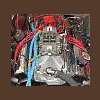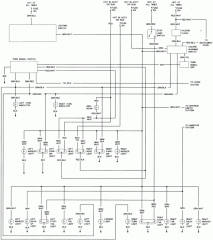-
Posts
203 -
Joined
-
Last visited
Content Type
Profiles
Forums
Blogs
Events
Gallery
Downloads
Store
Everything posted by Teekass
-
OMG, whoever designed those things was either a genius or completely strung out on shrooms or some other hallucinogen. I had a problem with my turn signal lever not staying engaged when turning to the right (http://forums.hybridz.org/showthread.php?t=123390). I was able to fix it, but didn't even come close to understanding exactly how that thing works mechanically.....geez! I'm glad my post did some good, and thanks for the motion to make it a sticky . Oh yeah, if you remove your turn signal assembly, it would be a good time to clean and WD40 the springs under the arrows, and make sure the ears that are hashed in red move freely and return to their original spot. These ears are what returns the turn signal lever back to off when you turn the steering wheel back to center.
-
Whoa, that would be great info. As many people as there are that struggle with which ohm range aftermarket fuel gauge to get (me being one of them), would be great to just have our sending unit rebuilt to match the gauge. If you get time, and find out who rebuilt yours, please let us know. Thanks in advance.
-
Early '77 280Z 2+2 125k miles. 355sbc/th350. Only been driveable a few weeks.....lots left to do! I'm putting a V6 in the Barbi Jeep.......if I could only figure out how to get my Mig to weld plastic .
-
Congrats! And I second the video request .
-
I've only done 1 swap, and I used the Hooker/Scarab mounts. It was very easy.....I actually did it alone with a hoist and a load leveler. For ease of installation, I think (but not from experience since I've never done a JTR swap) that the Hooker/Scarab kit is easier to install. Since you like running the car deep into corners, you would probably like the handling and lighter steering of the JTR kit......but I would ask someone who's had both. If I'm not mistakening, you can use the JTR radiator with the Hooker/Scarab engine position.
-
Thats great advice. Another thing to think about, since money is a concern, is get the transmission you want, even if it takes some patience while you save the money. Otherwise you will most likely waste money to get your "temporary" transmission to work. I know in theory it sounds cheaper to try to use your Datsun transmission, but it never works that way ......crossmember won't work, driveshaft needs to be shortened, or something else....and then you'd be spending money that could have been going towards the transmission you really wanted.
-
LED's for signals, that sounds neat. I'll have to do searching and read up on that. Thanks for the link...neat site! Can't wait to see some LT1 pics!
-
Wow, my first sticky....thanks alot guys ! Hey Daeron, my signals were weak and intermittent also. After cleaning the hazard switch and the turn signal switch, my signals work great. I mentioned how I cleaned the hazard switch, but not the turn signal....and I'm pretty sure these are the only 2 moveable contacts in the system. If you look at the last picture in my original post you can see 2 phillips head screws (one above and one below the 3 wires). Remove those 2 screws and the brownish colored plate will come off. Inside there is a U-shaped contact that fits up inside the turn lever. Mine was so gunked-up that it didn't even fall out, but be looking for it. I pulled the U-shaped contact out and cleaned it, along with the contacts on the inside part of the brown plate. It's sort of hard to explain but makes perfect sense once you take the brown plate off. Basically one leg of the U-shaped contact sits between the green wire and the white/red wire, and the other leg sits between the green wire and white/black wire. When you move the turn lever up it connects the green wire and white/red wire (down connects the green wire and the white/black wire). It was not hard at all though.......the hardest part was the time it takes to get to the turn signal assembly, and get it removed.
-
Thanks for all the input. Here's how I fixed it: I took a 1/8" drill bit, and elongated the top slot (as compared to the unaltered bottom slot). It's hard to explain without seeing how the switch moves, but basically there's a metal dowell that runs in these slots. When I turned to the right, the top dowel would hit the end of the slot and cause a pre-load on a spring that is inside the switch. When I released the turn signal lever, this pre-load would kick the lever back to the middle position. Elongating the slot allowed the turn signal lever to be placed in the turn position without pre-loading the spring.
-
Whoa! Camaro harness...sounds complicated, I'll keep my fingers crossed for you. Check out my new thread if you get bored.. http://forums.hybridz.org/showthread.php?t=123434
-
After spending much time searching threads and tracing wires, I thought I would post my findings on how the Hazard Switch and Turn Signal system works on my '77 2+2. After learning how it works, it's really not that complicated. The Hazard Switch is basically a double poled "On/On" switch. When the Hazards are turned OFF, the turn signals are turned ON (and vice/versa). When the Hazards are turned OFF, current still flows into the switch (from a switched hot power source), through the switch and supplies the Turn Signal system. When the Hazards are turned ON, it kills the current to the turn signals and a different power supply (constant hot) flows through the switch and supplies current to the Hazard system. This is why a bad Hazard switch can dork up the Turn Signals. Double-click or print to get a better view. The hazard system current comes from the fuse box constant hot red/white wire, goes to one of the poles on the hazard flasher, out of the hazard flasher via green/blue wire to the hazard switch harness clip where it turns to green/white, then to the hazard switch, then out of the hazard switch as green/black (right side flashers) and green/red (left side flashers)....These wires stay the same color when passing through the harness clip. The turn signal system starts with switch hot current (solid green wire), goes to the hazard switch harness clip, stays solid green when it passes through the clip, then goes to the other pole on the hazard switch. Current comes out of the hazard switch on the other solid green wire, goes to the harness clip and turns to green/ yellow, then goes to the turn signal flasher. It then goes out of the flasher via a solid white wire to the harness clip at the turn signal lever on the steering column. This wire turns solid green when it goes through the harness clip and is soldered onto the center of three wires on the back of the turn signal lever. When the lever is moved up or down, it sends current to either the top or bottom of these three wires white/black is left side turn signals (which turns to green/red when passing back through the harness clip), and white/red is right side turn signals (which turns to green/black when passing through the harness clip). The third circuit that goes TO the hazard switch (but doesn't actually go THROUGH the switch) is the little "Hazard" light (right below the switch) that illuminates when you turn on the headlights. Current goes to the light via the green/white wire that turns to red/ blue when passing through the hazard switch harness clip. Current goes through the bulb, and out through the black wire which turns to red/blue when passing back through the harness clip. I'm not sure what year car this schematic came from, but the wire colors were exactly the same on my '77, except that it doesn't mention the changing colors when passing through the harnesses....I'm pretty sure my harnesses are all factory though. I wish I would have taken pictures of my Hazard switch when I took it apart to clean. It was extremely simple though, and it works great now......There are 4 screws on the bottom of the switch. Remove them and pull off the cover. Be careful not to lose the spring that sits in the hole on the bottom side of the switch, or the piece of plastic on the end of the spring. From here, you can see the electrical contacts. The lever simply lifts off and is easily cleaned with a wire brush or similar. Hope this prevents some headaches someday!
-
That's great, sounds like your chipping away at it! Sound deadener.....cool! Speaking of having no turn signals, I pulled my hair out for a day and half trying to figure out why my turn signals were intermittent . Come to find out it was corroded contacts in the hazard switch. It appears the hazard switch is a On/On switch (as opposed to an On/Off). When the hazard switch is selected Off, it actually allows the current to go through it to supply the turn signals.....and when you turn ON the hazards, it kills the power to the turn signals, and supplys current to the hazards. In other words, the hazard switch is either On for the turn signals, or On for the Hazards. Wish I would have know that a week ago, LOL. Please keep us posted on your progress, and good luck.
-
Sorry, I missed this thread somehow. Belated congrats Dale. How's the project been going the last 2 weeks?


